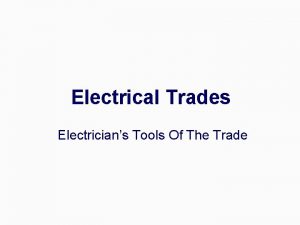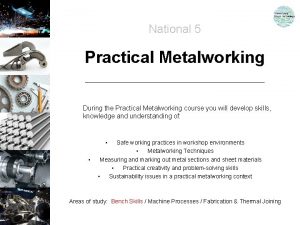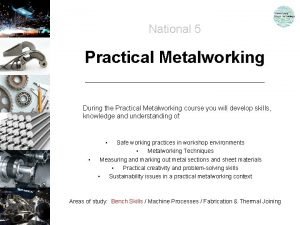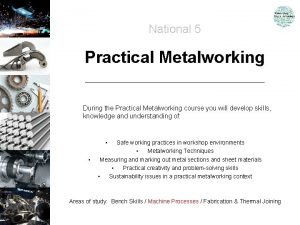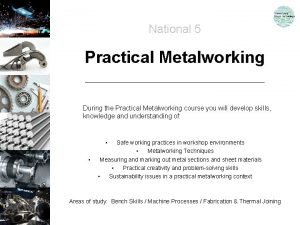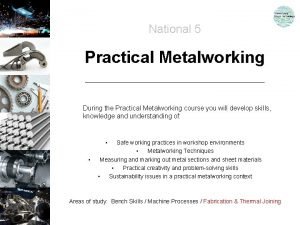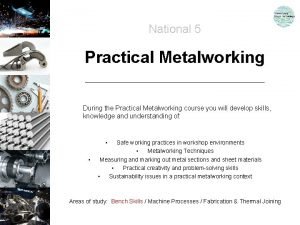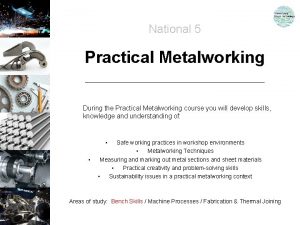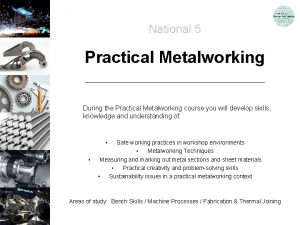National 5 Practical Metalworking During the Practical Metalworking









- Slides: 9

National 5 Practical Metalworking During the Practical Metalworking course you will develop skills, knowledge and understanding of: • • Safe working practices in workshop environments • Metalworking Techniques Measuring and marking out metal sections and sheet materials • Practical creativity and problem-solving skills • Sustainability issues in a practical metalworking context Areas of study: Bench Skills / Machine Processes / Fabrication & Thermal Joining

National 5 Practical Metalworking Unit 1: Bench Skills - Bending Metals Safety Rating: (Low)

Bench Skills: Bending Metal Bending/Folding Equipment Folding Bars The ‘Folding Bars’ are used in conjunction with the vice to insure an accurate bend when working with sheet metal or thin plate. A rawhide mallet and a piece of wood should be used to protect the material from damage when working. Metal Folder or Brake The ‘metal folder’ allows us to bend sheet metal over greater lengths. There are many types of metal folders. In the workshop it is common to have a hand operated folder but larger folders can be pneumatically, hydraulically or CNC operated.

Bench Skills: Bending Metal Bending/Folding Equipment Universal Bar Bender The universal ‘Bar bender’ can be fixed to the bench or in an engineers vice and will allow us to manually bend many different types of metal bar. There are many variations of this and like the folders, these can be pneumatically, hydraulically or CNC operated. Vice Mounted Folder The ‘vice mounted folder’ is a very useful tool as it is compact and easy to use. The dies are mounted in the vice magnetically. The press knife is also sectional and each can be removed allowing small boxes to be made.

Bench Skills: Bending As we have discussed, metals can be bent in a vice, in folding bars or using other expensive metal bending equipment. It all depends on the type and size of your work piece. Thin metal may be bent whilst cold, while thicker metal may need heating or ‘annealing’ before being worked. When bending thinner sheet metals, the material is marked where it is to be bent and clamped to the line directly in the vice or using ‘folding bars’. To prevent damaging the material you can use a hide mallet or place a piece of hardwood next to it before striking. We will look at the process of ‘annealing’ later in the course.

Bench Skills: Bending It is vital that our metal is marked accurately. Therefore, something we must understand is the ‘bend allowance’. The bend allowance is a measurement that relates the bent length of a piece of sheet metal to the flat length. As shown below, the bend allowance is the arc length of the bend on the neutral axis. There are exact formulae applied to help engineers work out bend allowances and it can get very confusing. However, today CAD/CAM software works out all of these finer details. This allows us to produce very accurate drawings and tooling for very complex digital machinery and processes.

Bench Skills: Bending The detailed drawings supplied during this course will display very specific dimensions for you to follow. The ‘bend allowance’ of each bend has been pre-determined by CAD software, leaving an accurate bend line for you to use with the folding bars. Bending sheet metal is a fairly simple process. It is possible to bend sheet metal accurately using only the vice and a prepared ‘former’. A wooden former is very useful if your are to repeat a gradual bend. However, we will mostly use the folding bars. The bars, as shown below, will allow for a very accurate bend but only if they are carefully and securely clamped to the bend line.

Quiz Questions 6. 0 Record answers in your notes jotter 1. What piece of bending equipment would I use for square bar sections of metal? 2. What tool should I use for larger sections of sheet metal? 3. What is the main hazard to consider when handling sheet metals? 4. What can we do to help with the bending of thicker sections of metal? 5. What is the name given to the length of metal deformed by the bending process? 6. What ‘F’ can we use to help with the shaping of gradual bends? 7. Name two ways we can protect the surface of our sheet metal before bending?

Quiz Questions 6. 0 Record answers in your notes jotter 1. What piece of bending equipment would I use for square bar sections of metal? Universal Bar Bender 2. What tool should I use for larger sections of sheet metal? Metal Folder or Brake 3. What is the main hazard to consider when handling sheet metals? Sharp Edges 4. What can we do to help with the bending of thicker sections of metal? Heating or Annealing 5. What is the name given to the length of metal deformed by the bending process? Bending Allowance 5. What ‘F’ can we use to help with the shaping of gradual bends? Former 5. Name two ways we can protect the surface of our sheet metal before bending? Use hide mallet or piece of hardwood
